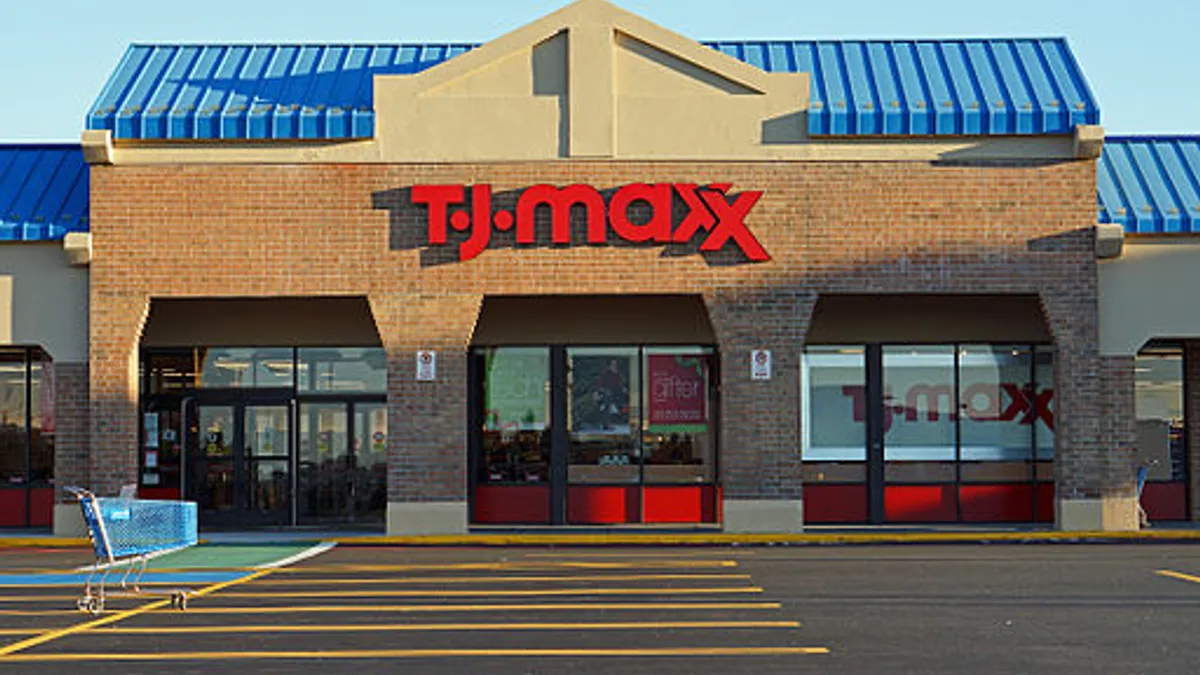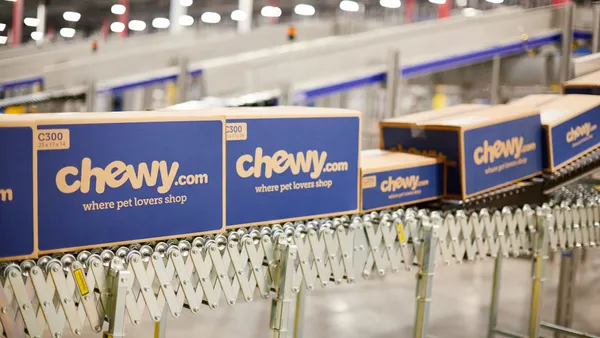Dive Brief:
-
TJX Cos., which runs T.J. Maxx, Marshalls, HomeGoods and Sierra Trading Post stores, on Tuesday said in a press release that first quarter net sales rose 3% to $7.8 billion, and diluted earnings were 82 cents per share, compared to 76 cents per share in the year-ago quarter, beating analyst estimates cited by Investors Business Daily for 79 cents per share on 7.88 billion.
-
Net income was $536 million as same-store sales rose 1%, down from its 7% boost in the year-ago period, and which Investors Business Daily noted missed some expectations. Shares slid 5.3% Tuesday morning on news of the weaker-than-expected report.
-
For the second quarter, TJX says it expects a diluted earnings per share range between 81 cents and 83 cents, compared to 84 cents last year, negatively impacted in part by currency fluctuations and wage increases. For the 53-week fiscal year, the company expects diluted earnings to range between $3.82 and $3.89 per share. This represents a 10% to 12% increase over the prior year’s $3.46.
Dive Insight:
TJX remains a much more robust retail company than most department stores, which last week continued to tell a sad story of badly declining sales — with J.C. Penney, Macy's and Dillard's all posting losses.
Still, TJX’s first quarter results revealed weakness that hasn’t been present in its previous reports. In his statement Tuesday, CEO Ernie Herrman said that the company saw positive performance despite unfavorable weather in the U.S. and Canada that its stores didn’t have to contend with last year.
“For the first quarter, consolidated comparable store sales were up 1% over last year’s strong 7% increase and at the high end of our plan,” he said. “Comp store sales growth was once again driven by customer traffic. …We were pleased to see sales trends pick up as the quarter progressed.”
The results show that even TJX is suffering from the overall softness in the apparel sector, GlobalData Retail managing director Neil Saunders said. "While neither Marshalls nor TJX has fallen out of favor with consumers, the amount of discounting and markdown activity across the apparel sector resulted in the customers of both chains shopping more widely than usual," he said in a note emailed to Retail Dive. "At the same time, interest in and demand for apparel waned, especially during the early part of the quarter. Both of these factors made it tough for TJX to increase its share of wallet from existing customers, and to attract new consumers, in the way it usually does."
Part of the challenge for TJX is that last year's results were stellar, and it's tough to post big numbers against such comparisons, Saunders said. Things will likely ease up for the company's retail units, especially as apparel sales pick up as Global Data Retail analysts expect them to. Its home goods sales aren't facing the same uphill as apparel. Still, the company is facing increased competition, and that, plus the strong dollar and the maturity of some of TJX's businesses will continue to slow things down, he said.
"[W]e believe that the year will be a softer one for TJX with comparable growth well below last year, likely coming in at around the 2% mark," Saunders said. "In the near-term earnings will also weaken, but thanks to strong operating discipline these should bounce back by year end. Ultimately, TJX will remain a winner in both apparel and home, but the days of easy growth are now firmly behind it."
Herrman noted that the company has a firm handle on inventory. Total inventories as of April 29 were $3.7 billion, compared with $3.9 billion at the end of the first quarter last year. Consolidated inventories on a per-store basis as of that day, including the distribution centers, but excluding inventory in transit and in its e-commerce businesses, were down 9% on a reported basis — compared to a 7% increase on both a reported and constant currency basis last year. The company said that it is in “an excellent inventory position” entering the second quarter and has plenty of liquidity to take advantage of “terrific buying opportunities” in the marketplace for quality, branded merchandise.
“With our disciplined inventory management, our merchandise margin was up, which speaks to the resiliency and flexibility of our off-price retail model,” Herrman said. “Further, we are confident that we are gaining market share at each of our four major divisions. The second quarter is off to a solid start and we have excellent liquidity in our inventories.”
It’s true that TJX is grabbing market share, particularly from retailers that are closing their doors at a rapid pace. Off-price retailers will get a bump from Macy’s' on-going plans to close some 100 stores, according to a note that BMO Capital Markets apparel and retail analyst John Morris released earlier this year. Burlington Coat Factory, which has 47 stores within five miles of a Macy’s slated for closure, will be a prime beneficiary. Off-price stores run by Burlington, TJX Cos. and Ross could snap up 40% of the $575 million in revenue that those closures will leave on the table, Morris estimated. Burlington stores could garner a 15-cent bump to per share earnings, while TJX’s TJ Maxx, Marshall’s, Sierra Trading Post and Home Goods may see a one cent per share boost, and Ross may see a 7-cent boost.















